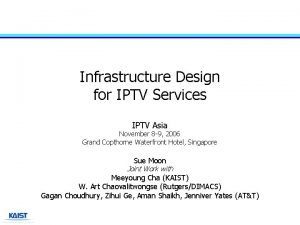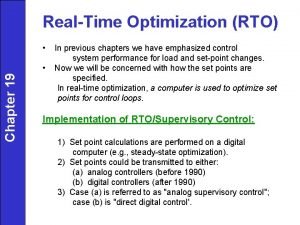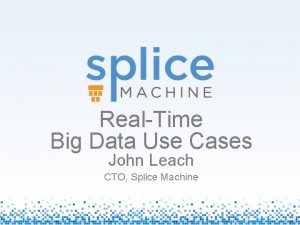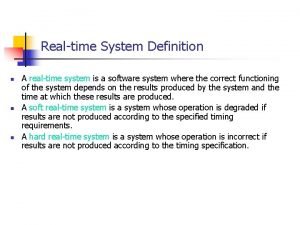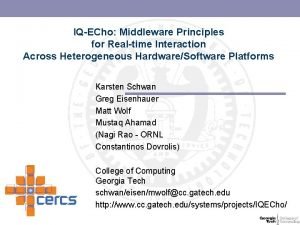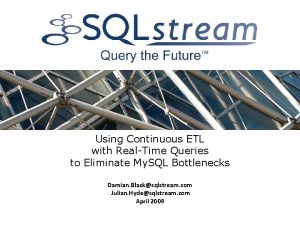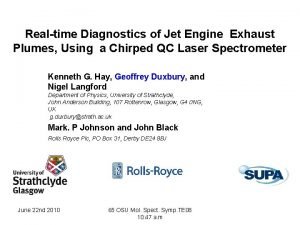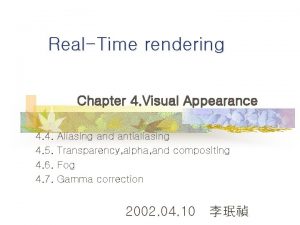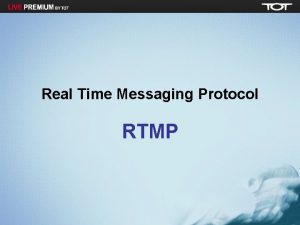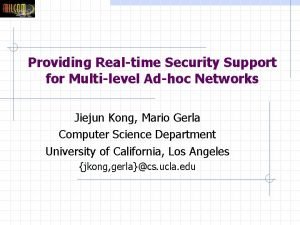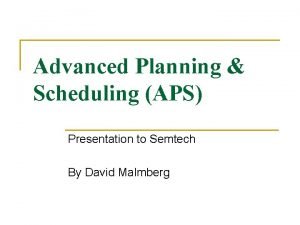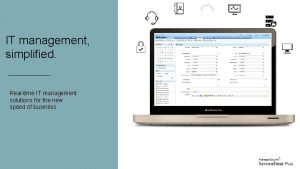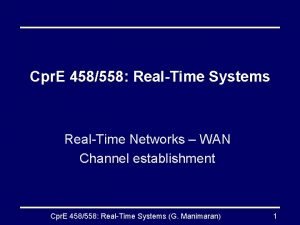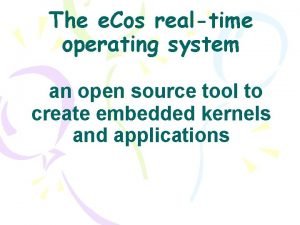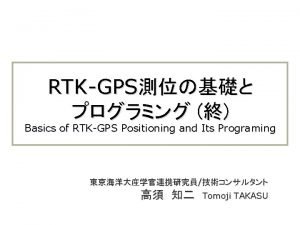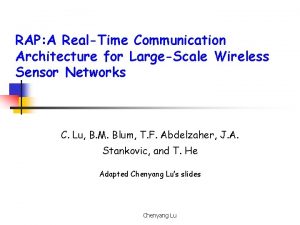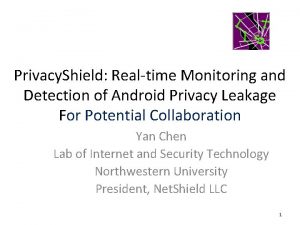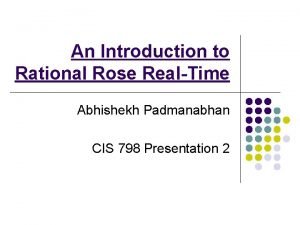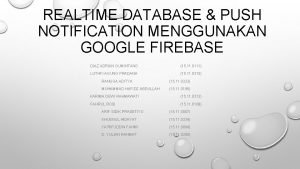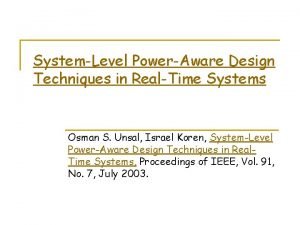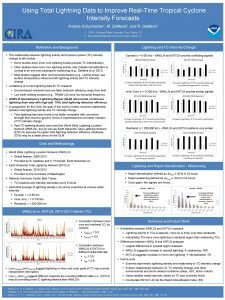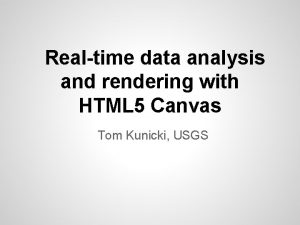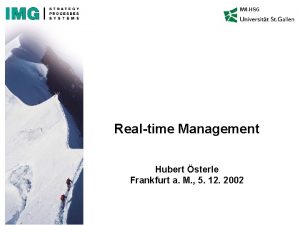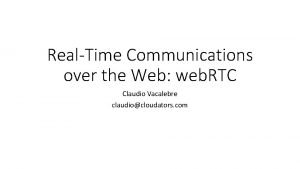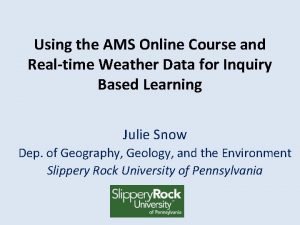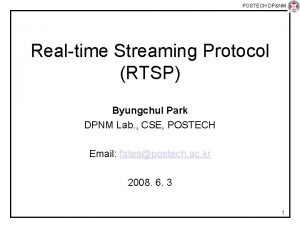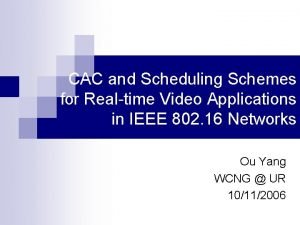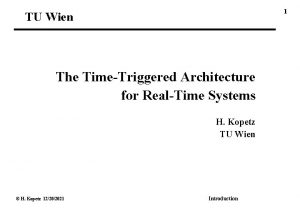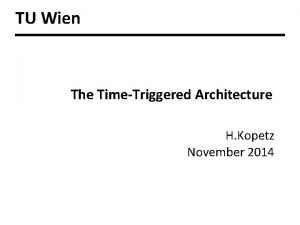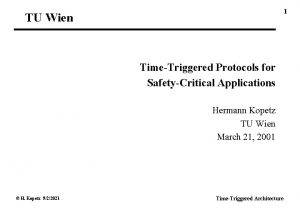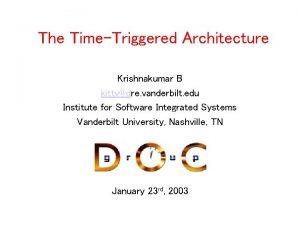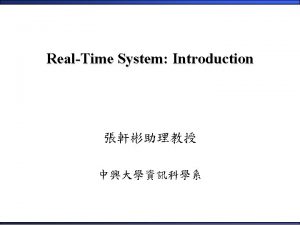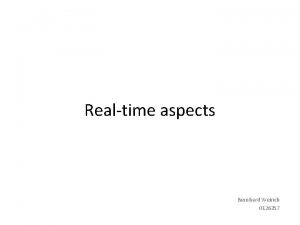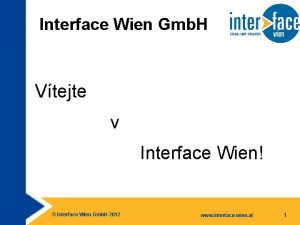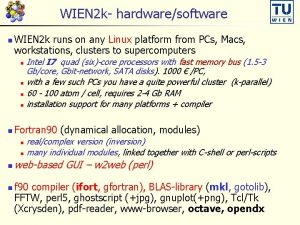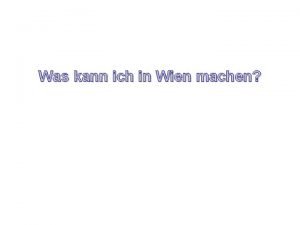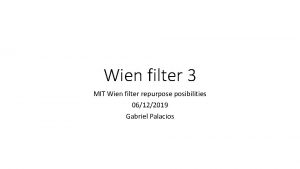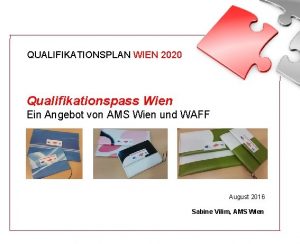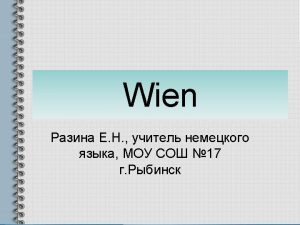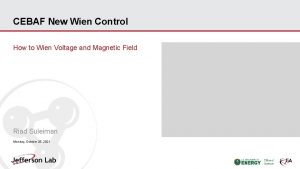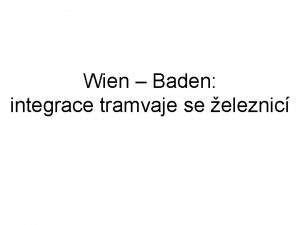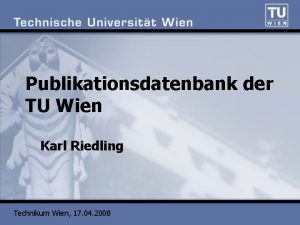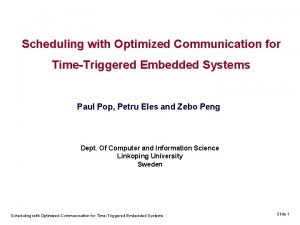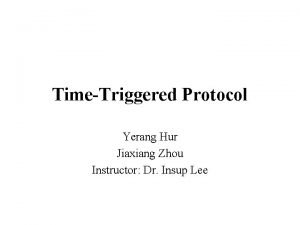1 TU Wien The TimeTriggered Architecture for RealTime




























































































- Slides: 92

1 TU Wien The Time-Triggered Architecture for Real-Time Systems H. Kopetz TU Wien © H. Kopetz 3/5/2021 Introduction

2 http: //stf. rgai. hu © H. Kopetz 3/5/2021 Introduction

3 Outline Introduction System Architecture Time-Triggered Protocols Composability--Temporal Firewalls Fault Tolerance Conclusion © H. Kopetz 3/5/2021 Introduction

4 Our Goal Our goal is to facilitate the systematic design of large dependable control systems out of components. The interactions of the components is realized by the exchange of messages across interfaces to a real-time communication system. The driving forces for the composition of a large System of Systems (SOS) out of a set of components (component systems) are: Cognitive complexity reduction in order to reduce the design and development effort Reuse of components: The components may be newly designed according to a given architectural style or may be already existing systems (legacy systems). Simplified diagnostics and repair. © H. Kopetz 3/5/2021 Introduction

5 Report on US Air Traffic Control In February 1997, the United States General Accounting Office (GAO) published a report to the Secretary of Transportation, Mr. F. Pena, about the design and implementation of the new air traffic control system in the US. The author of the report was Dr. R. B. Stillman, Chief Scientist for Computers and Telecommunications. © H. Kopetz 3/5/2021 Introduction

6 ATC Plagued by Problems “To illustrate, the long-time centerpiece of this modernization program--the Advanced Automation System (AAS)--was restructured in 1994 after estimated costs tripled from $2. 5 billion to 7. 6 billion and delays in putting significantly less-thanpromised system capabilities into operation were expected to run 8 years or more. ” “For example, the per-unit cost estimate for the Voice Switching and Control System increased 522 percent, and the first site implementation was delayed 6 years from the original estimate. ” Source: GAO Report to the Secretary of Transportation, February 3, 1997, p. 24 © H. Kopetz 3/5/2021 Introduction

7 Principal Findings of GAO Report An architecture is the centerpiece of sound system development and maintenance. FAA is developing a logical architectural component for ATC modernization and evolution. FAA lacks a technical architectural component to guide and constrain ATC modernization and evolution. Without a technical ATC architecture, costly system incompatibilities have resulted and will continue. FAA lacks an effective management structure for developing and enforcing an ATC systems architecture. © H. Kopetz 3/5/2021 Introduction

What is a Technical System Architecture? A technical system architecture is a framework for the construction of a system that constrains an implementation in such a way that the ensuing system is understandable, maintainable, extensible, and can be built cost-effectively. © H. Kopetz 3/5/2021 Introduction 8

9 Technical System Architecture (II) Architectural style: An architecture must provide rules and guidelines for the partitioning of a system into subsystems and for the design of the interactions among the subsystems. Composability: An architecture must provide a framework for the systematic construction of a system out of subsystems (components). Property Match: Components must comply with the architectural style to avoid a property mismatch at the component interfaces. Elegance: An architecture must constrain an implementation in such a way that the ensuing system is understandable, maintainable, extensible, and can be built cost-effectively--in other words, it is elegant. Architecture Design is Interface Design © H. Kopetz 3/5/2021 Introduction

10 Property Mismatches at Interfaces Property Physical, Electrical Communication protocol Syntactic Flow control Incoherence in naming Data representation Temporal Dependability Semantics © H. Kopetz 3/5/2021 Example Line interface, plugs, CAN versus J 1850 Endianness of data Implicit or explicit, Information push or pull Same name for different entities Different styles for data representation Different formats for date Different time bases Inconsistent time-outs Different failure mode assumptions Differences in the meaning of the data Introduction

Size versus Mental Effort to Understand Mental Effort (Complexity) Human Mental Capability If the mental effort required to understand a particular system function grows with the system size, there is an inherent limitation to the size of the systems we can build. Size © H. Kopetz 3/5/2021 Introduction 11

12 Complexity and Size Large systems can only be built if the effort required to understand the system operation, i. e, the complexity of the system, remains under control as the system grows. The effort to understand any particular system function should remain constant, and should be independent of the system size. A large system contains many more different functions than a small system. The effort needed to understand all functions of a large system grows with the system size. The design effort must be guided by technical system architecture. © H. Kopetz 3/5/2021 Introduction

Summary: A Good Distributed Architecture 13 provides a framework and guidelines for the composition of a system out of nearly autonomous components (subsystems) without the occurrence of property mismatches. defines an architectural style. specifies the type of interactions among the components across welldefined and small interfaces. It thus builds structure by weak intercomponent coupling and strong intra-component coupling. provides interfaces that are flexible enough to support the intended functions, but rigid enough to act as error containment boundaries. is based on already familiar orthogonal concepts that are used recursively. is scalable without limits. © H. Kopetz 3/5/2021 Introduction

Technology Trend to Distributed Systems System on a Chip (SOC) is the components: A complete computer system, including, CPU, Memory, I/O, Communication Controller, Operating Systems, and Application Software can be implemented on a single silicon die: e. g. , Motorola “Golden Oak” Smart Sensors: Sensing Element, signal processing, calibration, diagnosis, communication control on a single die. On-Chip Oscillators for low-cost nodes: cheap, but imprecise COTS: Commercial off the shelf components comprising hardware and software Integrated Fault Tolerance: to mask faults, e. g. SEU (single event upsets)--New failure modes of SOCs © H. Kopetz 3/5/2021 Introduction 14

15 Economics of Silicon real-estate requirements (today, i. e. in the year 2002): ARMcore 32 bit CPU: 1 mm 2 Infineon 256 Mbit DRAM: < 100 mm 2 : � 320 kbyte of DRAM: 1 mm 2 Marginal Production Costs of 1 mm 2 of silicon is in the order of 10 US cent (Cost at silicon foundry TSMC) Cost of packaging, testing, pins, power-supply significant and often dominant. Marginal production costs of 100 mm 2 silicon chip order of 10 US $. One men minute of work buys how many megabytes of RAM? © H. Kopetz 3/5/2021 Introduction

Time-Triggered Architecture (TTA) Safety without compromises No single point of failure Formal analysis of critical functions Composability: Building systems out of prevalidated components--Component reuse Fully specified operational interfaces in the temporal domain and value domain Two level design methodology Flexibility Flexible reuse of existing components. © H. Kopetz 3/5/2021 Introduction 16

17 TTA Overview H H H RT Communication System TR Digital on a sparse time-base TR Controlled Object © H. Kopetz 3/5/2021 H Host TR Transducer Data Sharing Interface Analog or Digital dense time-base Introduction

18 Design Principles of the TTA Establishment of a Consistent Distributed Computing Base Global Time at every Node Temporal Accuracy of of Real-time Data Distinction between State and Event Observations Interfaces specified in the domains of time and value Transparent Fault Tolerance © H. Kopetz 3/5/2021 Introduction

19 Validity of Real-Time Data How long is the observation: “The traffic light is green” temporally accurate ? The validity of real-time data is time dependent. © H. Kopetz 3/5/2021 Introduction

20 Definition: Temporal Accuracy The temporal accuracy of a RT image is defined by referring to the recent history of observations of the related RT entity. A recent history RHi at time ti is an ordered set of time points <ti, ti-1, ti-2, . . ti-k>, where the length of the recent history dacc = ti - ti-k is called the temporal accuracy. Assume that the RT entity has been observed at every time point of the recent history. A RT image is temporally accurate at the present time ti if © H. Kopetz 3/5/2021 Introduction

21 State and Event Observation An observation is a state observation, if the value of the observation contains the full or partial state of the RT-entity. The time of a state observation denotes the point in time when the RT-entity was sampled. An observation is an event observation, if the value of the observation contains the difference between the “old state” (the last observed state) and the “new state”. The time of the event information denotes the point in time of the L-event of the “new state”. © H. Kopetz 3/5/2021 Introduction

Example of State and Event Observation State observation (blue): <Name of RT entity, Time of observation, full value> The flow is at 5 l/sec a 10: 45 a. m. Event Observation (red): <Name of Event, Time of event occurrence, state difference> The flow changed by 1 l/sec at 10: 45 a. m. RT Image RT Entity © H. Kopetz 3/5/2021 Introduction 22

23 State versus Event Observations © H. Kopetz 3/5/2021 Introduction

24 Message A message is an atomic data structure that is formed for the purpose of inter-component communication. The endpoints of the communication are the component interfaces. In the temporal domain, a message can be characterized by The message send instant, i. e. the instant when the first bit of the message leaves the sender. The message receive instant, i. e. , the instant when the last bit of the message arrives at the receiver. © H. Kopetz 3/5/2021 Introduction

25 Interface The interface between two subsystems (cluster, component, etc. ) is characterized by Its data properties, i. e. , the structure and semantics of the data items crossing the interface Its temporal properties, i. e. , the temporal conditions that have to be satisfied by the interface: control and temporal data validity. The functional intent, i. e. , the assumptions about the functions of the interfacing partner In a non-real-time computer system, there is little concern about the temporal properties. © H. Kopetz 3/5/2021 Introduction

26 Distributed System Interfaces Component A Interface View © H. Kopetz 3/5/2021 Communication System Messages Component B Interface View Introduction

27 Elementary vs. Composite Interface Consider a unidirectional data flow between two subsystems (e. g. , data flow from sensor node to processing node). We distinguish between: Elementary Interface: Composite Interface: Control A Data B Example: state message in a DPRAM B Queue of event messages Control A Data Elementary interfaces are inherently simpler than composite interfaces © H. Kopetz 3/5/2021 Introduction

Information Push vs. Information Pull Information Push Interface: Information producer pushes information on information consumer (e. g. , telephone, interrupt) Information Pull Interfaces: Information consumer requests information when required (e. g, email). What is better in real-time systems? --For whom? © H. Kopetz 3/5/2021 Introduction 28

State Message versus Event Message 29 State Message: A periodic message that contains state observations (synchronous). Message handling: update in place and non-consuming read. Periodic state messages can be implemented as an elementary interface (no dependence of sender on receivers) with error detection at the receiver. Event Message: A message that contains event observations (asynchronous). Message handling: exactly-once semantics, realized by message queues. Requires a composite interface (dependence of sender on receivers) for error detection at the sender. (Compare “sampled message” and “queued message” in ARINC) © H. Kopetz 3/5/2021 Introduction

Time Triggered (TT) vs. Event Triggered (ET) A Real-Time system is Time Triggered (TT) if the control signals, such as sending and receiving of messages recognition of an external state change are derived from the progression of a (global) time. A Real-Time system is Event Triggered (ET) if the control signals are derived from the occurrence of events, e. g. , termination of a task reception of a message an external interrupt © H. Kopetz 3/5/2021 Introduction 30

31 Basic Elements of the TTA Assumes existence of a sparse global time and contains the following four basic elements: Interface: a data-sharing boundary between two communicating subsystems that contains temporally accurate state observations. Communication subsystem: transports real-time data in the from of state messages from an output interface to an input interface within a given time. Host computer: Reads input data from an input interface (information pull), performs a data transformation and writes output data into an output interface (information push) within a given a priori known duration. Transducer: Transforms output data from an interface into a form required by the system environment and transforms data from the environment into the form required by an input interface. © H. Kopetz 3/5/2021 Introduction

A Time-Triggered Architecture (TTA) Node Control signals and data items to and from the controlled object Interface to Transducerss Communication Network Interface (CNI) Host computer including application software Host Computer Communication Network Interface (CNI) Interface to Other Nodes Messages to and from the real-time communication system © H. Kopetz 3/5/2021 Introduction 32

33 TTP - Principle of Operation TTP generates a global time-base Media access is controlled by TDMA, based on this time Acknowledgement implicit by membership Error detection is at the receiver, based on the a priori known receive time of messages State agreement between sender and receiver is enforced by extended CRC calculation Every message header contains 3 mode change bits that allow the specification of up to seven successor modes © H. Kopetz 3/5/2021 Introduction

How well can we synchronize clocks? © H. Kopetz 3/5/2021 Introduction 34

35 Sparse Time Base If the occurrence of events is restricted to some active intervals with duration with an interval of silence of duration between any two active intervals, then we call the timebase / -sparse, or sparse for short. © H. Kopetz 3/5/2021 Introduction

36 Uniform Time Format--OMG Standard Time horizon Time granularity determined by precision of GPS Elapsed seconds since January 6, 1980 at 00: 00(GPS base). 240 seconds 1 sec 2 -24 sec external time format (8 bytes) Start of epoch: January 6, 1980 at 0: 00 UTC Granularity about 60 nanosecond © H. Kopetz 3/5/2021 Introduction

37 Time and State In abstract system theory (Mesarovic, p. 45), the notion of state is introduced in order to separate the past from the future: “The state enables the determination of a future output solely on the basis of the future input and the state the system is in. In other word, the state enables a “decoupling” of the past from the present and future. The state embodies all past history of a system. Knowing the state “supplants” knowledge of the past. Apparently, for this role to be meaningful, the notion of past and future must be relevant for the system considered. ” A precise concept of time is a prerequisite for a precise concept of state. © H. Kopetz 3/5/2021 Introduction

Global Interactions versus Local Processing Host Computer C N I CC+MEDL © H. Kopetz 3/5/2021 CC+MEDL C N I Host Computer I/O 38 In the TTA, the locus of temporal control is in the communication system. In ET systems, the locus of temporal control is in host computers. Introduction

39 TTP-Controller TTP-Time Interrupt Host CPU CNI in DPRAM TTP Controller TTP Control Data in MEDL Protocol Engine Replicated TTP Bus © H. Kopetz 3/5/2021 Introduction

40 Use of Apriori Knowledge The a priori knowledge about the behavior is used to improve the Error Detection: It is known a priori when a node has to send a message (Life sign for membership). Message Identification: The point in time of message transmission identifies a message (Reduction of message size) Flow control: It is known a priori how many messages will arrive in a peak-load scenario (Resource planning). For event-triggered asynchronous architectures, there exists an impossibility result: ‘It is impossible to distinguish a slow node from a failed node!’ This makes the solution to the membership problem very difficult. © H. Kopetz 3/5/2021 Introduction

41 Continuous State Agreement The internal state of a TTP controller (C-state) is formed by the Time Operational Mode, and Membership The Protocol will only work properly, if sender and receiver contain the same state. Therefore TTP contains mechanisms to guarantee continuous state agreement (extended CRC checksum) and to avoid clique formation (counts of positive and negative CRC checks). © H. Kopetz 3/5/2021 Introduction

42 TTP-A Objectives Composability and Testability Latency Guarantee for State Estimation Good Error Detection for fail safe operations Use of Standard UARTS (8 data bits with parity) High Data Efficiency (>50 %) and small latency Single wire (10 kbits) or twisted pair operation Clock Synchronization better than 1 msec © H. Kopetz 3/5/2021 Introduction

43 Fault-Tolerant Sensor Connection Fault Tolerant Unit TTP/A Bus A Sensors A TTP/A A Host TTP/C Controlled Object A FTU A TTP/C A Host TTP/A TTP/C A © H. Kopetz 3/5/2021 TTP/A master controller TTP/C controller TTP/A slave node interfacing to sensors and actuators TTP/C Bus Introduction

44 TTA and the CORBA Architecture Time-Triggered Architecture TTA CNI Object A ORB at A Corba Facilities: Time Internationalization Domain Specific, e. g, Banking Health Care Object B ORB at B Object Request Broker (ORB)--GIOP communication Corba Services: Naming Transaction Security Persistent State Event Notification, and more © H. Kopetz 3/5/2021 Introduction

Integration of TT and ET Services--the Options (i) 45 Parallel: Time Axes is divided into two parallel windows, where one window is used for TT, the other for ET, Two media access protocols needed, one TT, the other ET Loss of Temporal Composability TT ET Time (ii) Layered: ET service is implemented on top of a TT protocol Single time triggered access media access protocol. Loss of Global Bandwidth Sharing Time What are the consequences for global time and state? © H. Kopetz 3/5/2021 Introduction

Architecture Design is Interface Design A good interface within a distributed real-time system is precisely specified in the value domain and in the temporal domain, provides the relevant abstractions of the interfacing subsystems and hides the irrelevant details, leads to minimal coupling between the interfacing subsystems, limits error propagation across the interface, Conforms to the established architectural style and thus introduces structure into a system. © H. Kopetz 3/5/2021 Introduction 46

47 Composability Compose: “to make or form by combining things, parts, or elements” Composition: “the act of combining parts or elements to form a whole” Webster Encyclopedic Dictionary, 1989, p. 302 Composability: “The ease of forming a whole by combining parts” Parts: The component systems or the components Whole: A system of systems (SOS). A composition brings into existence new emerging services of the SOS that are more than the sum of the prior services of the components. These emerging services are the result of the integration of the component systems. © H. Kopetz 3/5/2021 Introduction

48 What is a “Component”? In our context, a component is complete computer system that is time aware. It consists of The hardware The system and application software The internal state The component interacts with its environment by the exchange of messages via interfaces. © H. Kopetz 3/5/2021 Introduction

Closed Component vs. Open Component Closed Component: Contains no local interface to the real world, but can contain local interfaces to other closed components. Semi-closed if it is time-aware. Open Component: Contains an interface to the real world. Semi-open if no control signals are accepted from the realworld (e. g. , a sampling system). The real world has an unbounded number of properties. © H. Kopetz 3/5/2021 Introduction 49

50 Interfaces of a Component Diagnostic and Management Interface (Boundary Scan in Hardware Design) Local Interfaces Application Software Linking Interface (LIF) Relevant for Composability Configuration Planning Interface © H. Kopetz 3/5/2021 Introduction

51 Interfaces of a Component (ii) Realtime Service (RS) Interface--the linking interface LIF: In control applications periodic Contains RT observations Time sensitive Diagnostic and Maintenance (DM) Interface: Sporadic access Requires knowledge about internals of a node Not time sensitive Configuration Planning (CP) Interface: Sporadic access Used to install a node into a new configuration Not time sensitive Local Interface(s): To other nodes or the environment Not visible to the user of the component © H. Kopetz 3/5/2021 Introduction

How is the “Integration” achieved? The component systems are integrated by the exchange of messages across linking interfaces (LIF). Our focus is on what are the contents of a message (data) and when a message is sent and received (time). We abstract from the low-level (physical, coding) aspects of communication. We assume that all property mismatches of the interacting systems have been resolved by a connection system. © H. Kopetz 3/5/2021 Introduction 52

Only RS Interface Important for Composability An RS interface to a RT service module (e. g. , a control algorithm) must specify: At what point in time the input information is delivered to a module (temporal pre-conditions) At what point in time the output information must be produced by the module (temporal post-conditions). The properties of the intended information transformation provided by the module (a proper model) The RS interface contains RT images of the relevant RT entities. © H. Kopetz 3/5/2021 Introduction 53

54 Interface Specification Operational Specification: Operational Input Interface Specification Syntactic Specification Temporal Specification Input Assertion Operational Output Interface Specification Syntactic Specification Temporal Specification Output Assertion Interface State Meta-level Specification: Meaning of the data elements: Means-and-ends model © H. Kopetz 3/5/2021 Introduction

Views of a System: Four Universe Model User Level Meaning of Data Types Informational Level Data Types Meta-level Specification Interpretation by the User Operational Interface Specification Value and Temporal Logical Level Bits Physical Level Analog Signals Avizienis, FTCS 12, 1982 © H. Kopetz 3/5/2021 Introduction 55

Operational Input Interface Specification Syntactic Message Specification: Forms information chunks out of the bit-stream of a message using a interface definition language (e. g. , IDL of the OMG): e. g. , numbers, operations, text (see: Four Universe Model) Temporal Message Specification: Specifies when a message is expected: instant, phase, frequency Operational Input Assertion: Specifies an executable predicate on the incoming message (and the interface state) of a component to determine whether the message is permitted at the given instant. Many specifications do not contain a precise temporal specification and the operational input assertions. © H. Kopetz 3/5/2021 Introduction 56

Operational Output Interface Specification Syntactic Message Specification: Specifies the structure of an outgoing message: e. g. , numbers, operations, text (see: Four Universe Model) Temporal Message Specification: Specifies when a message must be sent: instant, phase, frequency Operational Output Assertion: Specifies a predicate on the outgoing message of a component to be able to determine whether the message is well-formed. © H. Kopetz 3/5/2021 Introduction 57

58 Interface State The state of a component as seen from the point-of-view of the interface: Only a (small) subset of the full state of the component Simplified if a sparse time model is supported Methods to access the interface state should be provided at the interface © H. Kopetz 3/5/2021 Introduction

59 Meta-Level Specification The meta-level specification provides an interface model in order that the meaning of the information chunks that cross the interface can be established: Hierarchical Model according to means-and-end relationship Understandable to the user of the interface Limits to formalization if components are open © H. Kopetz 3/5/2021 Introduction

Reasoning about the Emerging Services The specification of the LIF message interfaces that are involved in a composition must be sufficient to reason about the properties of the emerging services: LIFs must be precisely specified in the time and value domain Interface model behind a LIFs should refer only to those aspects of a component systems that are required for the composition. Dependence of the subsystem operation on the correct functioning of a LIF partner should be minimized (Otherwise, violation of the principle of the stability of prior services). Only if the LIF specification is easier to comprehend than the full subsystem specification, a complexity reduction is achieved. © H. Kopetz 3/5/2021 Introduction 60

(Cognitive) Interface Complexity An interface provides a view into a system. The cognitive complexity of this view depends on Interface model Number and interaction of elements visible at the interface Representation (Documentation) of the interface Experience of the observer . . . The time it takes for an “average” user to understand an interface documentation is a possible quantitative measure of cognitive interface complexity. © H. Kopetz 3/5/2021 Introduction 61

Complexity Reduction by Partitioning Complexity Reduction: (LIF Service Interface Complexity)/(Component Complexity) A good decomposition will lead to a significant complexity reduction for the understanding of the emerging functions at the system level. The easier it is, to understand a LIF interface, the better the decomposition from the point of view of complexity management. © H. Kopetz 3/5/2021 Introduction 62

Complexity Reduction by Partitioning Complexity Reduction: (LIF Service Interface Complexity)/(Component Complexity) A good decomposition will lead to a significant complexity reduction for the understanding of the emerging functions at the system level. The easier it is, to understand a LIF interface, the better the decomposition from the point of view of complexity management. © H. Kopetz 3/5/2021 Introduction 63

A Composition Involving three LIFs Linking Interfaces (LIFs) © H. Kopetz 3/5/2021 Introduction 64

The Five Principles of Composability (LIF) (1) Independent Development of the Components (Architecture) (2) (3) (4) (5) 65 The message interfaces of the components must be precisely specified in the value domain and in the temporal domain in order that the component systems can be developed in isolation. Stability of Prior Services (Component Implementation) The prior services of the components must be maintained after the integration and should not fail if a partner fails. Performability of the Communication System (Comm. System) The communication system transporting the messages must meet the given temporal requirements under all specified operating conditions. Replica Determinism (Architecture) Replica Determinism is required for the transparent implementation of fault tolerance Diagnosability (Architecture) It must be possible to diagnose a faulty component © H. Kopetz 3/5/2021 Introduction

66 Common Composability Violations Missing temporal specification of interfaces concerning message rates and message receive instants (1). Prior services are impaired by excessive load across an information push interface (e. g. , interrupts) (2). At the critical instant, the communication system does not meet the temporal requirements of the applications (3). Missing replica determinism destroys the fault-tolerance strategy (4). Error propagation: The prior services of a component become dependent on a fault of a LIF partner (2). Diagnosis: Impossibility to determine the sender of an incorrect message (e. g. , CAN) (5) © H. Kopetz 3/5/2021 Introduction

Temporal Firewall Interface in the TTA A temporal firewall interface is a unidirectional elementary data flow interface for the exchange of state information. is located in a dual ported RAM of a communication controller --update-in-place semantics the instants when data is fetched (delivered) from (to) the communication system are a priori common knowledge to all communicating partners (error detection!) eliminates control error propagation since no control signal cross the temporal firewall interface Input Firewall: Assumptions Output Firewall: Guarantees © H. Kopetz 3/5/2021 Introduction 67

Temporal Firewall Information Flow Information flow Control flow © H. Kopetz 3/5/2021 Introduction 68

69 Temporal Firewall Characteristics Fully specified in the domains of time and value and of low cognitive complexity: Information Content: State Message versus Event Message Role: Linking Interface (LIF) versus Local Interface Dependency: Elementary versus Composite Control: Information Push at Sender and Information Pull at Receiver Error Detection: Sender versus Receiver The Temporal Firewall Interface is the simplest interface we were able to come up with. © H. Kopetz 3/5/2021 Introduction

A Temporal Firewall is a Natural Concept A temporal firewall is a high-level abstract concept. It is a small and stable unidirectional interface that provides understandable abstractions of the relevant properties of the interfacing subsystems. Timeliness is an integral part of the temporal firewall concept. Conceptually, the RT images in the temporal firewall are closely related to the image presented by a sensor of an analog RT entity in the environment. Temporal firewalls are thus based on an accustomed view of the world. © H. Kopetz 3/5/2021 Introduction 70

71 Localized View of Global System © H. Kopetz 3/5/2021 Introduction

Stable Properties of Temporal Firewalls The following stable properties of temporal firewalls are known a priori to all interfacing partners: The addresses (names) and the syntactic structure of the data items in the temporal firewall. A (abstract) model explaining the meaning of the data items contained in the temporal firewall. The points on the global time base when the data items in the temporal firewall are accessed by the TT communication system. This information enables the avoidance of race conditions between the producer and the consumer. The temporal accuracy of the data items in the temporal firewall. This knowledge is important to guide the information consumer about the minimum rate of sampling of the temporal firewall. © H. Kopetz 3/5/2021 Introduction 72

73 Temporal Firewalls and Validation Assume a host that is encapsulated between two temporal firewalls, and input firewall and an output firewall. These two firewalls form the only interfaces of this host to its environment. The stable properties of the input firewall form important preconditions for the validation of the component under consideration. Many assumptions about the environment are contained in the specification of this input firewall. The stable properties of the output firewall form important postconditions of the validation. In the validation process it must be demonstrated that the postconditions, given in the output firewall specification, are always TRUE, provided the preconditions associated with the input firewall hold. © H. Kopetz 3/5/2021 Introduction

74 Example: A Five Cluster System H H Collision Avoidance H ECluster H H H Transponder H © H. Kopetz 3/5/2021 T Radar H RT Image in Temporal Accuracy Relationship to RT entity ECluster H T Controlled Object (State Variables T are called RT-Entities) T Introduction

Temporal Firewalls and Composability A composable architecture must support the (1) Independent development of components--relates to the architecture (2) Stability of prior services--relates to the components (3) Performability of the Communication System--relates to the communication system. (4) Replica determinism--to support transparent implementation of fault tolerance. (5) Diagnostics--It mus be possible to identify the sending FCU (Fault Containment Unit) of every message. The temporal firewall concept supports these principles of composability. © H. Kopetz 3/5/2021 Introduction 75

Top-Down Design Process in the TTA Level 1: Decompose the design problem into clusters and components Allocate functions to components Investigate the data flow among the components Specify the temporal firewalls in value and time Estimate the failure rates and specify the fault-hypothesis Specify the NGU Strategy Level 2: Implement the components, taking the temporal firewall specifications as constraints. © H. Kopetz 3/5/2021 Introduction 76

Composability and Reuse of Components Composability and the effortless reuse of available components are highly intertwined: The precisely defined component interfaces of a composable architecture specify clearly what a user has to supply and what a user can expect from an existing component. The “stability of prior service” principle ensures that the functions of the existing component are not disturbed by the integration. The “constructive integration” principle ensures that the component integration is linear and not circular. © H. Kopetz 3/5/2021 Introduction 77

Bottom-up Design--Reuse of Components The bottom up design takes advantage of the existing COTS components: The input firewall parameters determine what a user is expected to supply The output firewall parameters determine what a user can rely upon The architecture design must proceed taking these component characteristics as constraints. The temporal firewalls of the new components can be designed according to the top-down process. © H. Kopetz 3/5/2021 Introduction 78

79 Legacy Systems In many application legacy systems have to be integrated in a new design: Identify the “Linking Interface” of the legacy system. Provide a gateway component that hides the idiosyncracies of the legacy system and provides a standard interface (wrapper technology) to the new architecture. Provide back-pressure flow control in the gateway component. © H. Kopetz 3/5/2021 Introduction

80 Localized View of Global System © H. Kopetz 3/5/2021 Introduction

81 System States of a FT System States outside States covered by Normal Failures Rare Events Correct States FT Mechanisms Fault-Hypothesis Fault Hypothesis © H. Kopetz 3/5/2021 NGU Strategy Introduction

Systems on a Chip (SOC) Failure Modes In the future, new failure modes are expected to occur due to the high integration density: Multi-bit failures caused by SEUs Intermittent failures due to proximity effects In safety-critical applications, an SOC must be considered to form a single fault-containment region with no restricting assumptions about its possible failure modes. © H. Kopetz 3/5/2021 Introduction 82

Slightly off Specification (SOS) Failure Special type of Byzantine failure: A component produces an output signal (in the value domain or in the temporal domain) that is slightly outside the specified operating interval. Some receivers interpret the result correctly, some others cannot interpret the result. Voltage SOS Sender Receive Window A © H. Kopetz 3/5/2021 B C D Correct Sender E Introduction 83

84 Example: Brake by Wire System ABS Master ABS A master with an SOS failure can cause inconsistencies. © H. Kopetz 3/5/2021 Introduction

85 Physical Interconnection Structure Fail-silent faults G G G G TTP-Bus Arbitrary Faults TTP-Star © H. Kopetz 3/5/2021 Guardian Introduction G G

TTA Fault Containment and Error Detection © H. Kopetz 3/5/2021 Introduction 86

Order of Magnitude of Failure Rates The following table gives an order of magnitude estimate of possible failure rates in an automotive environment: © H. Kopetz 3/5/2021 Introduction 87

88 Fault-Tolerant Unit (FTU) A fault-tolerant unit (FTU) is a set of actively redundant components that provide a fault tolerant service to its environment: FTUs have to receive identical input messages in the same order FTUs have to operate in replica determinism The output messages of FTUs should be idempotent As long as a defined subset of the components of the FTU is operational, the FTU is considered operational FTUs provide the continuous service by fault masking. © H. Kopetz 3/5/2021 Introduction

89 Active Redundancy: TMR © H. Kopetz 3/5/2021 Voter Voter Introduction

90 Design (Software) Faults The application of fault-tolerance techniques to tolerate software faults by design diversity is still an open research area: If a disciplined software development process is followed most remaining failures are due to incorrect specification Even independent programming teams tend to make similar errors Replica Determinism can get lost if different algorithms are used However, an independent check of safety assertions makes sense. © H. Kopetz 3/5/2021 Introduction

91 Multilevel Architecture High Level Cluster Real-Time Buses Lower Level Cluster with limited functionality, implemented on diverse hardware and diverse software. Field Bus Sensors and Actuators © H. Kopetz 3/5/2021 Controlled Object Introduction

92 Conclusions The Time-Triggered Architecture provides a framework for the constructive design of dependable distributed realtime systems. Essential system functions (clock synchronization, membership) are implemented in hardware to simplify the application development. Major industries (aerospace, automotive, railway) are supporting the paradigm shift towards the time-triggered technology. © H. Kopetz 3/5/2021 Introduction
 Copthorne hotel
Copthorne hotel Realtime optimization
Realtime optimization Simple online and realtime tracking
Simple online and realtime tracking Realtime big data
Realtime big data Real-time system definition
Real-time system definition Realtime it
Realtime it Realtime interaction
Realtime interaction Halthywa
Halthywa Realtime etl
Realtime etl Realtime forex
Realtime forex Realtime diagnostics
Realtime diagnostics Rendering realtime compositing
Rendering realtime compositing Real time messaging protocol
Real time messaging protocol Ad hoc realtime
Ad hoc realtime Gullistan carpet
Gullistan carpet Realtime it
Realtime it Realtime networks
Realtime networks Rtim real time interaction management
Rtim real time interaction management Cos realtime
Cos realtime Eva rov
Eva rov Realtime mobile communication
Realtime mobile communication Real time operating system concepts
Real time operating system concepts Alyac realtime service
Alyac realtime service Rose realtime
Rose realtime Firebase push notification android
Firebase push notification android Realtime it
Realtime it Js code
Js code Realtime
Realtime Lightning realtime
Lightning realtime Rendering realtime compositing
Rendering realtime compositing Frankfurt realtime
Frankfurt realtime Realtime iep
Realtime iep Realtime communications
Realtime communications Ams realtime weather maps central
Ams realtime weather maps central Realtime streaming protocol
Realtime streaming protocol Cac realtime
Cac realtime Steg för steg rita
Steg för steg rita Fspos vägledning för kontinuitetshantering
Fspos vägledning för kontinuitetshantering Orubbliga rättigheter
Orubbliga rättigheter Ministerstyre för och nackdelar
Ministerstyre för och nackdelar Tillitsbaserad ledning
Tillitsbaserad ledning Vem räknas som jude
Vem räknas som jude Bästa kameran för astrofoto
Bästa kameran för astrofoto Bunden till c-dur
Bunden till c-dur Nyckelkompetenser för livslångt lärande
Nyckelkompetenser för livslångt lärande Ro i rom pax
Ro i rom pax Shingelfrisyren
Shingelfrisyren Mästare lärling modell
Mästare lärling modell Matematisk modellering eksempel
Matematisk modellering eksempel Bamse för de yngsta
Bamse för de yngsta Verktyg för automatisering av utbetalningar
Verktyg för automatisering av utbetalningar Shivaismen
Shivaismen Kyssande vind
Kyssande vind Kolopskopi
Kolopskopi Boverket ka
Boverket ka Strategi för svensk viltförvaltning
Strategi för svensk viltförvaltning Anatomi organ reproduksi
Anatomi organ reproduksi Vad är verksamhetsanalys
Vad är verksamhetsanalys Typiska drag för en novell
Typiska drag för en novell Tack för att ni har lyssnat
Tack för att ni har lyssnat Centrum för kunskap och säkerhet
Centrum för kunskap och säkerhet Läkarutlåtande för livränta
Läkarutlåtande för livränta Klassificeringsstruktur för kommunala verksamheter
Klassificeringsstruktur för kommunala verksamheter Inköpsprocessen steg för steg
Inköpsprocessen steg för steg Påbyggnader för flakfordon
Påbyggnader för flakfordon Tack för att ni lyssnade
Tack för att ni lyssnade Egg för emanuel
Egg för emanuel En lathund för arbete med kontinuitetshantering
En lathund för arbete med kontinuitetshantering Stickprovsvarians
Stickprovsvarians Atmosfr
Atmosfr Rutin för avvikelsehantering
Rutin för avvikelsehantering Vad är vanlig celldelning
Vad är vanlig celldelning Presentera för publik crossboss
Presentera för publik crossboss Myndigheten för delaktighet
Myndigheten för delaktighet Att skriva en debattartikel
Att skriva en debattartikel Kung dog 1611
Kung dog 1611 Tobinskatten för och nackdelar
Tobinskatten för och nackdelar Nationell inriktning för artificiell intelligens
Nationell inriktning för artificiell intelligens Referatmarkering
Referatmarkering Programskede byggprocessen
Programskede byggprocessen Sten karttecken
Sten karttecken Fimbrietratt
Fimbrietratt Rbk fuktmätning
Rbk fuktmätning Kraft per area
Kraft per area Elektronik för barn
Elektronik för barn Kassaregister ideell förening
Kassaregister ideell förening Vad är densitet
Vad är densitet Tack för att ni har lyssnat
Tack för att ni har lyssnat Borra hål för knoppar
Borra hål för knoppar Bris för vuxna
Bris för vuxna Smärtskolan kunskap för livet
Smärtskolan kunskap för livet Frgar
Frgar Jiddisch
Jiddisch
